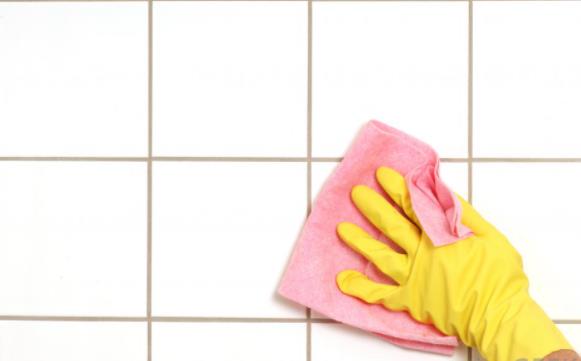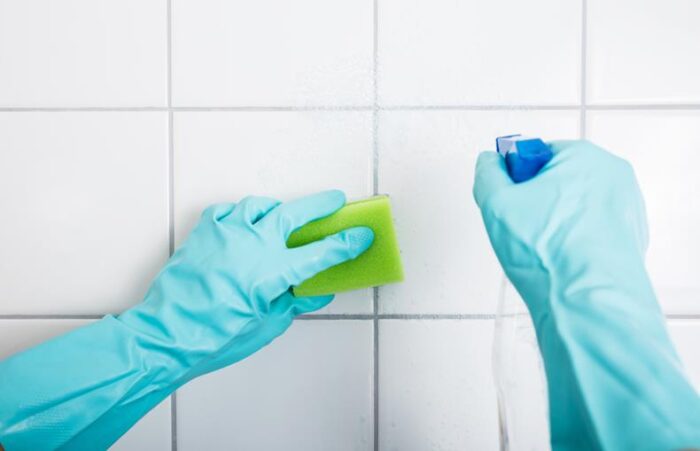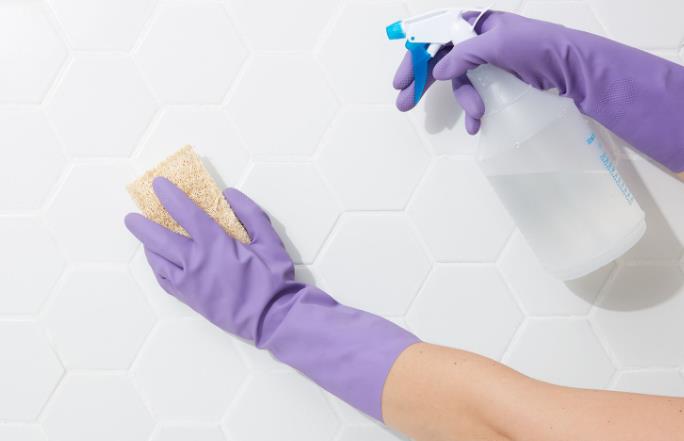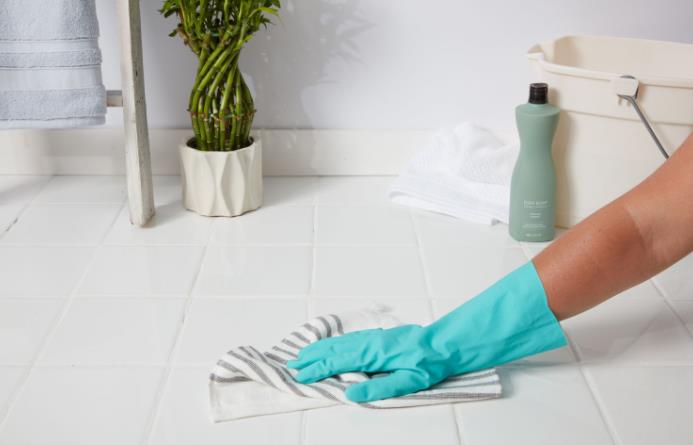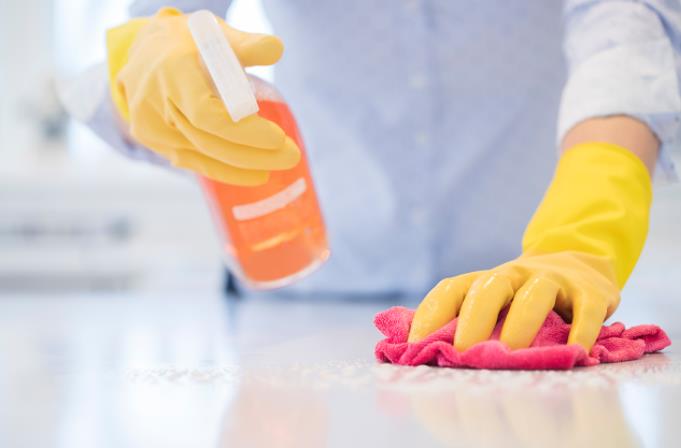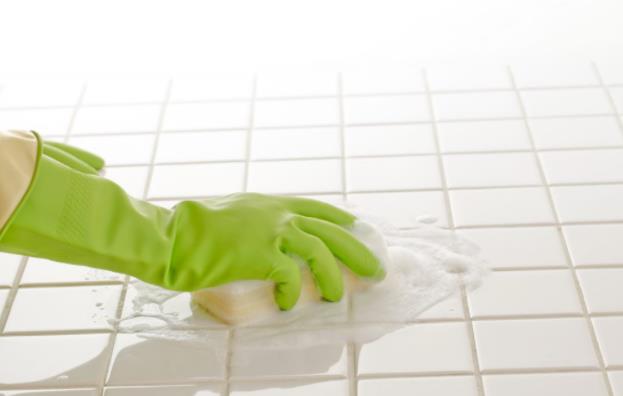Tiles have become widely used due to how durable they are thus preferred in most rooms like the kitchen, bathroom, laundry room, etc. However, it is a seemingly hard task to keep them in great condition. You may wonder: how to remove stains from tile floors?
In the article, we will focus on types and how to remove these stains and so much more. Let’s dive in.
How to Remove Different Types of Stains From Tile Floors?
Different types of stains need different methods and step to clean.
- Coffee, tea, fruit, juice, wine stains
Saturate a paper towel or a piece of cloth with hydrogen peroxide and then apply to the stains.
Then wash the tile surface with mild detergent and water, rinse and dry.
- Grease stains
Wash the stain with club soda and hot water.
- Ink permanent marker
Diluted bleach
Soak a cloth with a diluted bleach mixture and place it on the stain. Let it sit for around 15 minutes or until the stain is gone. Rinse the area with hot water and dry.
Dry eraser
Take a dry eraser cleaning sponge and rub the stain, then wipe down with soapy water, rinse and dry.
Peroxide and oxygen cleaner.
Step 1: Soak a piece of cloth with hydrogen peroxide and place it on the stain. Blot the ink with a cloth while pressing it firmly. Take care to use a clean area of the cloth so that the stain not to spread.
Step 2: Saturate another clean cloth with hydrogen peroxide and let it sit on the stain for five minutes.
Step 3: Then rinse with water. In case there is any ink residue, apply several drops of oxygen cleaner to stain the residue, then scrub with a soft brush.
Step 4: Let it sit for 15 minutes, rinse and dry.
- Bloodstains
Bloodstains are crucial stains that require thorough cleaning and due to the use of strong chemicals ensure you have rubber gloves.
Step 1: With a ratio of 10-1 in disinfecting, fill a bucket of water with one cup of bleach to ten cups of hot water and mix thoroughly. Pour the solution on the stain or spray it with a spray bottle.
Step 2: Wipe the area with a towel or cloth. Repeat the first step and leave the solution to evaporate, this disinfects the area.
Step 3: Then rinse the area with water to remove any more traces of bleach.
Step 4: Take a cloth and saturate it with hydrogen peroxide then place it on the stain. Give it a few minutes where peroxide absorbs the stain.
Step 5: Rinse with warm water and dry it thoroughly.
- Gum, tar, wax stains
Either gum, tar, or wax stain has always been a bother while on the tile floor making it look unappealing. But don’t let it faze you anymore, here is how to get rid of it.
Step 1: Place a bag of ice cubes or ice pack to the area with any of the above stains and let it sit still until it is cold and has solidified.
Step 2: Take a blunt-wooden craft stick or a silicone-tipped stick, and remove as much substance forming the stain as you can. This kind of stick is ideal to prevent scratching the tile.
Step 3: Wipe the remaining residue with a non-flammable paint thinner carefully ensuring not to touch the grout.
Step 4: Later, rinse with water and dry.
- Hard water stains
The water that comes from wells or municipal water pipes most likely has magnesium and calcium minerals in it. These minerals make the water lack a slippery feeling as it gets hard.
Consequently, when water evaporates, it leaves an ultrathin coating with the minerals. The stains are faint white rings of crystals outlining the drops as they shrink and evaporate. Thus, there is a need to get rid of these stains, and below are ways of removing them.
Use of vinegar
Step 1: Take a cloth or a sponge and soak it with vinegar, use it to wipe the wet surface with hard water stains.
Step 2: Allow the vinegar to soak in the surface for a few minutes, then wipe the surface to wet it again.
Step 3: Sprinkle baking soda in small amounts to the surface with vinegar. It will fizzle due to the reaction with vinegar.
Step 4: Scrub the surface gently with a sponge dampened with water.
Step 5: Then rinse the area with water to wash away the vinegar and baking soda. Dry the dry immediately with a soft cloth thus preventing more water spots from forming.
Use of Salt
This is a kitchen ingredient that is very useful in removing stubborn water stains from your tiles.
Step 1: Sprinkle salt on the tiling floor and leave it for an hour or more.
Step 2: Scrub the salt using a sponge or brush.
Step 3: Rinse the surfaces, to get rid of salt.
Use of Micro Abrasive Cleaner
Using this method you need a micro-abrasive product like Bon Ami. This mildly micro-abrasive product that is in powder form can be used on kitchen surfaces and tiles.
Step 1: Make a paste.
Mix equal parts of the water and powder to make a paste and then apply it on the stained surface and leave it for up to 15 minutes.
Step 2: Rub the area.
Rub the area with a sponge and cloth to get rid of the stains. Then rinse thoroughly with water and wipe until it’s dry.
However, if the stains are only mild, simply sprinkle the powder and scrub it with a sponge and cloth.
Step 3: Rinse and dry.
Finally, so that you remove the excess paste, rinse it with clear water. Then dry the area later to prevent the stain from reforming.
- Rust stains
These types of stains are common when metal items like metal furniture, home décor items, utensils of LPG cylinders are placed on tile surfaces that come in contact with moisture for a long period.
The rust is mostly caused due to contact with hard water which later makes the floor messy and unclean while it also may result in weakening the tiles. There is a remedy to remove the stains from your floor. Below is how to remove the stains.
Use of toothpaste
Toothpaste is among the best mild cleaning agents when made with baking soda, not only does it clean the dental plaque but also clean stains and scuffs. There is a variety of toothpaste in the market.
Step 1: Take a thin coat of toothpaste and cover the rust stain.
Step2: Pick a soft-bristled toothbrush and start rubbing the surface with rust stain in a circular motion.
Step 3: Finally, clean the tiles with water or tissue paper.
Use lemon
This is a fruit that contains a high concentration of citric acid and is among one of the best natural cleaners in any household. It is capable of removing rust stains from tile floors and even removing germs due to its antibacterial properties.
Step 1: Squeeze a lemon and extract lemon juice in a bowl and add a pinch of salt.
Step 2: Pour ¼ of a teaspoon over the rust stain.
Step 3: Leave it for at least 10 minutes and then use a soft-bristled toothbrush to clean it down. The stain will start disappearing.
Vinegar
This is among the most preferred household cleaners. It is acidic and is versatile due to its variety of uses. The acidity in nature is so powerful that it dissolves stubborn stains in no time.
Step 1: Pour 2-3 teaspoons of vinegar on the rust stain and let it sit for 3-5 minutes.
Step 2: Wipe the floor with a clean soft cloth.
What to Use to Remove Tough Stains from Tile Flooring?
When removing those stubborn stains from tile floors, you need items that will assist you to clean them up. Below are some of the items you need to use.
- Scrub brushes, Mop
- Baking soda, Hydrogen peroxide
- Toothbrush for grout
- Rubber gloves, Pail, Sponge, Cloth
- Lemon, Oxygen-based cleaner
- Bleach, Paint thinner
- Wooden craft stick, Broom and dustpan
How to Remove Stains on the Grout Between Tiles?
There is nothing that looks ugly and dirty like a stained grout, even though the tiles are sparkly clean, the grout will steal the better picture. Grout is very challenging to clean due to how porous it is while it absorbs stains easily.
Here are methods of cleaning the stubborn stains from the grout leaving the room shiny.
- Hot water and vinegar method
Step 1: Wipe the stained area with hot water to get rid of excess dirt.
Step 2: Take an empty spray bottle and fill it with a mixture of vinegar and hot water half bottle.
Step 3: Spray the solution to the grout and let it sit for at least 5 minutes.
Step 4: Then scrub the grout using a toothbrush. However, for faster operation, while using less energy, use an electric toothbrush with a high setting. Or you can just use a steam mop – the easiest and simple way to make your grout clean!
Step 1: Finally, rinse the area with water.
- Sandpaper method
Step 1: Fold the sandpaper into two.
Step 2: Rub the creased edge of the grout line, rub going back and forth until the strain is gone.
Step 3: Rinse with hot water.
- Plain warm water method
This is used for mild stains.
Step 1: Using a spray bottle, spray warm water in the grout line.
Step 2: Scrub in circular motions until the stain wears out.
Step 3: Let the floor dry.
- Baking soda paste and vinegar
Step 1: Make a paste of baking soda and water.
Step 2: Cover the grout lines with the paste.
Step 3: Spray the solution of vinegar mixed with hot water over the paste.
Step 4: Scrub with a brush when the mixture stops foaming.
Step 5: Rinse with plain water.
- Pencil Eraser method
Step 1: Take a pencil eraser and rub along the stained grout line.
Step 2: Continue with the exercise back and forth until the stain is gone.
Step 3: Rinse with hot water.
- Baking Soda and Hydrogen peroxide method
This is a solution used for a moderately stained grout as you won’t need to use vinegar or any other acidic solution.
Step 1: Mix one part peroxide and two parts baking soda and put the solution in an empty spray bottle.
Step 2: Spray the solution on a stained grout and scrub with a soft brush. Note that using a hard brush may scratch your tiles.
Step 3: Then make a paste of two-part baking soda and one part water and apply the paste to the stain. Let it stay overnight.
Step 4: Scrub the stain with a nylon brush.
Step 5: the surface with hot water.
- Chlorine bleach method
This method can only be used in a strong stain on the grout. Use the chlorine bleach sparingly on the tiled floor in extreme cases.
Things to Avoid when Removing Stains from the Tiles
When removing the stains from tiles, there is the measure you are ought to follow while others you are not supposed to do. The don’ts are specified enough to ensure that you preserve the condition of your tiles. Below are don’t when removing stains from your tiles.
Products like ammonia and bleach-based agents should not be used regularly because they might discolor your grout. Thus look for a professional to help out with the removal of the stained grouts.
- Don’t let dirt accumulate on your tiled floor. This happens to be the worst enemy for tile floors.
- Don’t clean with every stair removal product and cleaner to your flooring, since not all stain removal products are compatible with your tikes.
- Always make sure that you read the label and if possible check the manufacturer of your flooring.
- Avoid wearing certain shoes like cleats or high highs which have the possibility of scratching your floor.
- Avoid oil-based cleaners. When they are used on the shiny/glazed tiles it has the possibility of making it slippery which has the potential of causing accidents.
- Avoid leaving your tiles wet after cleaning them. Wipe any moisture and dry thoroughly to preserve your floor for longer.
- Don’t use a chemical cleaner that emits fumes. If at all they need to be used, use them sparingly, and ensure that the room is ventilated well. Children and pets should be kept away when cleaning.
How to Prevent Stains on Tiles?
To avoid stains, you need to follow the following steps.
- In the kitchen
Removal of stains in a tiled kitchen isn’t a walk in the park while having a clean and all sparkly floor is what every owner is looking for. Below are steps to undertake that helps you avoid the stains at all costs.
Step 1: Mop your tiled floor with very hot water frequently, at least once a week.
Step 2: When foods and drinks spill to the floor, wipe as fast as possible to avoid them settling. Ensure to wipe the surface with an antimicrobial cloth afterward.
Step 3: In the case some molds and stains do not wipe away, mix a cup of vinegar and a gallon of water, and continue mopping the floor as usual.
Step 4: Later, rinse the floor with warm water and after all the stain is cleaned up, remove all the water from the tiles.
- In the bathroom
Whether you just installed the tiles in your bathroom or you did a heck of work cleaning the stains out, you can avoid them on your bathroom tiles altogether. Below is the step.
Step 1: Ensure to wipe the tiles at least once a week with a specialized cleaning solution to ensure that stains are unable to form.
Step 2: For tough stains, mix 25% of bleach with 75 % soda in a cup. Rub the sections with stains and rinse them clean. These will keep the stains away.
Conclusion
Don’t let yourself go through headaches due to the stains in the tile that are hindering you from portraying your beautiful home. As much as they are stubborn, with the right procedures, they are no longer visible due to how effective the activities are.
The information above gives you all you need to remove these stains without any hassle.

